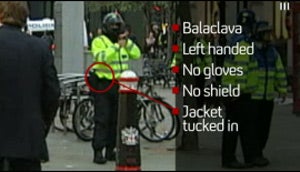Tim Walker: ‘Despite his balaclava, amateur cameras picked out U41’s helmet number’
The Couch Surfer

There’s no CCTV footage of the moment that the police officer, currently known to the public only as U41, struck Ian Tomlinson with his baton and pushed him to the ground.
But where Big Brother may have failed, Little Brother succeeded. A week or so ago, alerted to its existence by Jon Snow’s micro-blog, I watched in wonder a report on the now-infamous incident by Channel 4 News (tinyurl.com/c6ru44).
Using a mixture of ITN footage, camera phone clips and YouTube extracts, reporter Simon Israel and the – no doubt tiny – production team tracked, dispassionately, U41’s movements in the minutes leading up to that fateful shove.
All the action took place in a small cluster of recognisable City streets. And, despite his balaclava, professional and amateur cameras could pick out the offending officer thanks to his clothing arrangements, his left-handedness, and the number on his helmet.
The Independent Police Complaints Commission tried in vain to secure an injunction to prevent the footage being shown, claiming it would prejudice the Met’s internal investigation, which may lead to U41 being charged with manslaughter.
But few who saw the report could argue that it wasn’t in the public interest. Citizen journalists have taken us to the heart of events before, providing traditional news outlets with blurred images of the 7/7 bombings; Twitter feeds full of the Hudson River air crash; or endless tedious snaps of snowmen.
But this is the first time I’ve seen users’ news properly examined, editorialised, and employed as an integral part of a full-blown investigation.
Channel 4’s report proved that citizen journalism can be an exceptionally valuable resource. In the case of IanTomlinson’s death, it brought to light information that might otherwise have gone undiscovered by the official newsgathering structures. But it also demonstrated the need for some sort of expert filter, devoted to turning that raw material into a balanced bit of news content.
Like everyone else in the media, I’ve been listening to a lot of talk about its future recently. Even if the fate of frontline reportage were, say, people tweeting the spread of swine flu, or instantly uploading camera phone footage from the ground in Gaza, news junkies will still need someone skilled at collating that information and turning it into a balanced report.

Watch Apple TV+ free for 7 days
New subscribers only. £8.99/mo. after free trial. Plan auto-renews until cancelled

Watch Apple TV+ free for 7 days
New subscribers only. £8.99/mo. after free trial. Plan auto-renews until cancelled
Those filters may not be newspapers or, indeed, television news broadcasts. They may be five guys in their bedrooms in Aberdeen, or Auckland, or Addis Ababa, who are particularly proficient at surfing YouTube or distilling the twittersphere for mass consumption.
This, after all, is what Channel 4 News did – and, in principle, it’s what a lot of journalists have done for some time, with mixed results.
But whatever the future of familiar news sources, even those guys in their bedrooms will need to attract a critical mass of readers or viewers in order to become a trusted brand.
Oh, and they’ll need to find someone to pay them for it. Some find this inevitable market correction a bit terrifying.
I’m trying my best to find it exciting. State of Play is a film partly about the demise of traditional newsgathering, and the ways in which it’s compromised by the rise of internet journalism.
The movie itself, however, is invaded by new media – and not just in the form of Rachel McAdams’ plucky blogger. Actor Brennan Brown is best known to cinema audiences as “that bloke from the Orange ads”.
His character in said ads leads a group of mobile phone middle management types, who hold regular pitch meetings with movie stars in search of funding. Brown and his cohorts try to coerce Rob Lowe, Patrick Swayze et al into injecting ludicrous mobile phone references in their scripts.
Orange’s brand management has always been impeccable, and this is an endearing set of self-deprecatory commercials, but it does somewhat disrupt one’s enjoyment of Brennan’s acting elsewhere.
Iconic commercials work must be a problem for serious actors. How long did it take Buffy fans to stop thinking of Anthony Head as the fella from the Gold Blend ads?
About 10 minutes into State of Play, Ben Affleck, as a thrusting young senator, is hauled before his superiors to explain the nature of his relationship to a pretty intern. One of them tells him he ought to call his wife.
The camera pans to Brown, and I almost expected him to pull out a new Orange phone and suggest, ever-so-discreetly, that Affleck text her instead.
Subscribe to Independent Premium to bookmark this article
Want to bookmark your favourite articles and stories to read or reference later? Start your Independent Premium subscription today.

Join our commenting forum
Join thought-provoking conversations, follow other Independent readers and see their replies